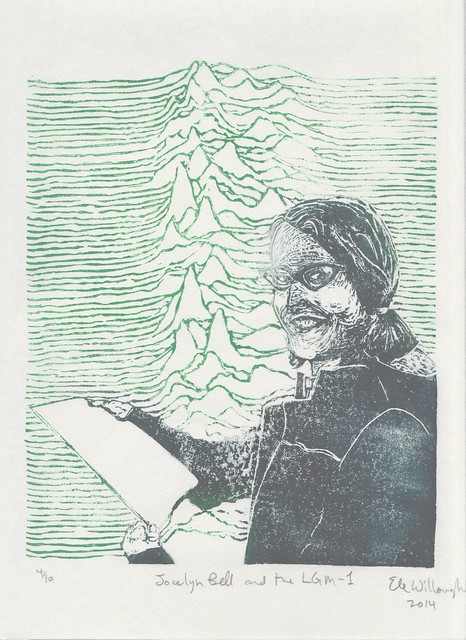 |
| Marie Tharp and the Mid-Atlantic Ridge, 9" x 12" linocut on Japanese paper, by Ele Willoughby, 2015 |
Tharp had struggled to find the the right university major; she wanted something she could do, and enjoy, but there were not many options for women in her day. More opportunities opened up during WWII and she took the chance to return to school and study geology and then math. Looking for something challenging (but not tedious) she contacted Maurice 'Doc' Ewing at Lamont-Doherty Earth Observatory at Columbia, who hired her to draft data, including the thousands of echo sounder profiles they were gathering. Women were still not allowed to participate in research cruises, but they could work with the data. Before long, Heezen came to Lamont and required so much drafting work that Tharp worked exclusively with him.
Scientists once imagined the ocean floor as a largely featureless plain. Early depth measurements were taken with lead weights (such as canon balls) and a whole lot of rope! As early as the late 19th century, such laboriously collected datasets began to hint at a broad rise in the centre of the Atlantic. By the mid 20th century, there was a push to try and map these submarine mountains.
Tharp spent months painstakingly "plotting, drawing, checking, correcting, redrawing and rechecking" profiles of the North Atlantic. The ship tracks across the Atlantic were a sparse web, but when Tharp compared half a dozen more or less parallel transects she noticed no only the general similarities of the ridge, but a V-shaped notch in the centre of all the profiles. She suspected they coincided because they indicated a rift valley all along the ridge crest. The early ideas about plate tectonics or the "continental drift" theory were still quite controversial and unpopular. Heezen dismissed Tharp's observation as "girl talk" for looking too much like continent drift - as in fact it was indeed a vital piece of the plate tectonics puzzle. We now know that surface of the Earth is itself a jigsaw puzzle of pieces known as tectonic plates, jostling one another at a stately, geological pace. Mid-ocean ridges are underwater volcanic mountain chains which roughly bisect all ocean basins. They are all cut by a rift valley which is the spreading centre. These rifts are where new crust is born, pushing upwards and outward. This drives the two plates on either side slowly apart over geological time. On our own timescales of everyday life, we notice the bumps in this slow ride: the sporadic earthquakes, rather than the slow creep (though today, we can meticulously measure both).
Tharp believed the rift was real though her contour maps hadn't convinced Heezen. In 1952, they began working on physiographic maps, which would show seafloor topography as if you were flying just above it, and the water were drained away. These had the advantage of really giving a sense of the variety of geology, from plains to mountains, seamounts to trenches. Also, unlike detailed contour maps, physiographic maps were not US Navy classified information, so Tharp and Heezen would be able to publish what they produced. Further, they were beginning to gather much better precision depth recorder data, which revealed far more features, along with better navigation to plot ships' positions along tracks more accurately. A second project in their research group involved plotting earthquakes, and Heezen insisted they work at the same scale. Heezen then noticed that ocean earthquake epicentre data also formed long lines - and in fact, when one map was placed above the other on a light table they found the earthquakes formed near continous lines along the Mid-Atlantic ridge right where Tharp had indicated there was a rift valley. Using the earthquake data to extrapolate and plot the rift position where there was no seafloor sounding data, they found that the rift extend landward into the Rift Valley of East Africa - a well-known, easy to observe terrestrial rift valley. Heezen was then convinced. They had discovered a worldwide mid-ocean ridge system, tens of thousands of kilometres long. Tharp was able to mine existing data to show the Mid-Atlantic Ridge extended to the south Atlantic and found similar features in other oceans. These all similarly lined up neatly with earthquake epicentres. Ewing and Heezen announced their findings in 1956. In 1957 Tharp and Heezen published their North Atlantic physiographic map; I've shown my version of their map behind her. The ridge snakes from top to bottom (north to south-south-west), above and almost mimicking the line of her arm.
 They continued this work, extending to other oceans over the next 25
years, ultimately producing detailed physiographic maps of the world
oceans. Their pioneering work mapping the oceanic plate boundaries, and
showing their clear alignment with seismic data helped fuel the
revolution in geology and geophysics, the paradigm shift of plate
tectonics.
They continued this work, extending to other oceans over the next 25
years, ultimately producing detailed physiographic maps of the world
oceans. Their pioneering work mapping the oceanic plate boundaries, and
showing their clear alignment with seismic data helped fuel the
revolution in geology and geophysics, the paradigm shift of plate
tectonics.Tharp's work was largely in the background during her university career, though she won a number of prizes during her retirement and has continued to gain posthumous recognition for the importance of her work and observations. I was very pleased to see her recognized recently in Neil DeGrasse Tyson's Cosmos reboot. I want to bring her incredible insight and excellent work to a wider audience as both artist and marine geophysicist myself.
(cross posted from the minouette blog)







